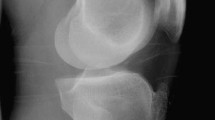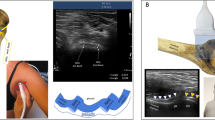Abstract
The histological changes found in the supraspinatus tendon have similarities with the findings in Achilles-, patellar- and extensor carpi radialis brevis (ECRB)-tendinopathy. In recent studies, we have found a vasculo-neural ingrowth in chronic painful Achilles and patellar tendinopathy, and demonstrated good short-term clinical effects with injections of the sclerosing substance polidocanol. In this collaborative two-centre pilot study, 15 patients (10 males and 5 females, mean age 46 years) with a long duration of shoulder pain (mean 28 months), and given the diagnosis chronic painful shoulder impingement syndrome, were included. They had tried rest, traditional rehabilitation exercises and multiple subacromial corticosteroid injections, without effect. We found vascularity (neovessels) in chronic painful, but not in pain-free, supraspinatus tendons, and prospectively studied the clinical effects of ultrasound (US) and colour Doppler (CD)-guided injections of polidocanol, targeting the area with neovessels. The patients evaluated the amount of shoulder pain during horizontal shoulder activity on a visual analogue scale (VAS), and satisfaction with treatment. Two (median) (range 1–5) polidocanol treatments (with 4–8 weeks in between) were given. In four patients (considered treatment failure), cortisone was injected into an inflamed subacromial bursa at one separate occasion weeks after the last polidocanol injection. At follow-up, 8 (median) (range 4–17) months after the treatment, 14 patients were satisfied with the result. Using the visual analogue scale evaluation (VAS), the pain dropped from 79 before treatment to 21 at follow-up (P < 0.05). In the short-term perspective, sclerosing polidocanol injections targeting the neovessels in the supraspinatus tendon and/or bursa wall seems to have a potential to reduce the pain during shoulder loading activity.



Similar content being viewed by others
References
Alfredson H, Öhberg L, Forsgren S (2003) Is vasculo-neural ingrowth the cause of pain in chronic Achilles tendinosis? An investigation using ultrasonography and colordoppler, immunohistochemistry, and diagnostic injections. Knee Surg Sports Traumatol Arthrosc 11:334–338
Alfredson H, Öhberg L (2005) Sclerosing injections to areas of neovascularisation reduce pain in chronic Achilles tendinopathy: a double-blind randomized controlled trial. Knee Surg Sports Traumatol Arthrosc 13:338–344
Alfredson H, Öhberg L (2005) Neovascularisation in chronic painful patellar tendinosis promising results after sclerosing neovessels outside the tendon challenges the need for surgery. Knee Surg Sports Traumatol Arthrosc 13:74–80
Chansky HA, Iannotti JP (1991) The vascularity of rotator cuff. Clin Sports Med 10:807–822
Cohen R, William G (1998) Impingement syndrome and rotator cuff disease as repetitive motion disorder. Clin Orthop 351:95–100
Desmeules F, Cote CH, Fremont P (2003) Therapeutic exercise and orthopedic manual therapy for impingement syndrome: a systematic review. Clin J Sport Med 13:176–182
Fukuda H, Hamada K, Nakajima T, Yamada N, Tomonaga A, Gotoh M (1996) Partial-thicness tears of the rotator cuff. A clinicopathological review based on 66 Surgically verified cases. Int Orthop 20:257–265
Fukuda H (2003) The managment of partial-thickness tears of the rotator cuff. J Bone Joint Surg Br 85:3–11
Gotoh M, Hamada K, Yamakawa H, Inoue A, Fukuda H (1998) Increased substance P in sudacromial bursa and shoulder pain in rotator cuff disease. J Orthop Res 16:618–621
Hawkins RJ, Kennedy JC (1980) Impingement syndrome in athletes. Am J Sports Med 31:724–727
Hyvonen P, Lohi S, Jalovaara P (1998) Open acromioplasty does not prevent the progression of an impingement syndrome to a tear. J Bone Joint Surg Br 8:813–816
Khan KM, Cook JL, Bonar F, Hardcourt P, Åström M (1999) Histopathology of common Tendinophaties. Sports Med 27:188–201
Lind B, Öhberg L, Alfredson H (2006) Sclerosing polidocanol injections in mid-portion Achilles tendinosis: remaining good clinical results and decreased tendon thickness at 2-year follow-up. Knee Surg Sport Traumatol Arthrosc (Accepted)
Ljung BO, Alfredson H, Forsgren S (2004) Neurokinin 1-receptors and sensory neuropeptides in tendon insertions at the medial and lateral epicondyles of the humerus. Studies on tennis elbow and medial epicondylalgia. J Orthop Res 22:321–327
Neer CS (1983) Impingement lesions. Clin Orthop 173:70–77
Öhberg L, Lorentzon R, Alfredson H (2001) Neovascularisation in Achilles tendons with painful tendinosis but not in normal tendons: an ultrasonographic investigation. Knee Surg Sports Traumatol Arthrosc 9:233–238
Öhberg L, Alfredson H (2002) Ultrasound guided sclerosis of neovessels in painful chronic Achilles tendinosis: pilot study of a new treatment. Br J Sports Med 36:173–177
Öhberg L, Alfredson H (2003) Sclerosing therapy in chronic Achilles tendon insertional pain-results of a pilot study. Knee Surg Sports Traumatol Arthrosc 11:339–343
Pope DP, Craft PR, Pritchard CM, Silman AJ (1997) Prevalence of shoulder pain in the community: the influence of case definition. Ann Rheum Dis 56:308–312
Sharma P, Maffulli N (2005) Tendon injury and tendinopathy: healing and repair. JBJS (Am) 87:187–202
Van der Heijden GJ, Van der Vindt DA, De Winter SF (1997) Physiotherapy for patients with soft tissue shoulder disorders: a systematic review of randomised clinical trials. BMJ 315:25–30
Yanagisawa K, Hamada K, Gotoh M, Tokunaga T, Oshika Y, Tomisawa M, Hwan Lee Y, Handa A, Kijima H, Yamazaki H, Nakamura M, Ueyama Y, Tamaoki N, Fukuda H (2001) Vascular endothelial growth factor (VEGF) expression in the subacromial bursa is increased in patients with impingement syndrome. J Orthop Res 19:448–455
Author information
Authors and Affiliations
Corresponding author
Rights and permissions
About this article
Cite this article
Alfredson, H., Harstad, H., Haugen, S. et al. Sclerosing polidocanol injections to treat chronic painful shoulder impingement syndrome-results of a two-centre collaborative pilot study. Knee Surg Sports Traumatol Arthrosc 14, 1321–1326 (2006). https://doi.org/10.1007/s00167-006-0205-8
Received:
Accepted:
Published:
Issue Date:
DOI: https://doi.org/10.1007/s00167-006-0205-8




